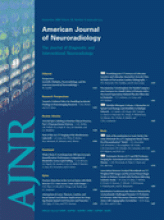Abstract
BACKGROUND AND PURPOSE: While brain MR imaging is routinely performed, the MR imaging assessment of spinal cord pathology in multiple sclerosis (MS) is less frequent in clinical practice. The purpose of this study was to determine whether measurements of medulla oblongata volume (MOV) on routine brain MR imaging could serve as a biomarker of spinal cord damage and disability in MS.
MATERIALS AND METHODS: We identified 45 patients with MS with both head and cervical spinal cord MR imaging and 29 age-matched and sex-matched healthy control subjects with head MR imaging. Disability was assessed by the expanded disability status scale (EDSS) and ambulation index (AI). MOV and upper cervical cord volume (UCCV) were manually segmented; semiautomated segmentation was used for brain parenchymal fraction (BPF). These measures were compared between groups, and linear regression models were built to predict disability.
RESULTS: In the patients, MOV correlated significantly with UCCV (r = 0.67), BPF (r = 0.45), disease duration (r = −0.64), age (r = −0.47), EDSS score (r = −0.49) and AI (r = −0.52). Volume loss of the medulla oblongata was −0.008 cm3/year of age in patients with MS, but no significant linear relationship with age was found for healthy control subjects. The patients had a smaller MOV (mean ± SD, 1.02 ± 0.17 cm3) than healthy control subjects (1.15 ± 0.15 cm3), though BPF was unable to distinguish between these 2 groups. MOV was smaller in patients with progressive MS (secondary- progressive MS, 0.88 ± 0.19 cm3 and primary-progressive MS, 0.95 ± 0.30 cm3) than in patients with relapsing-remitting MS (1.08 ± 0.15 cm3). A model including both MOV and BPF better predicted AI than BPF alone (P = .04). Good reproducibility in MOV measurements was demonstrated for intrarater (intraclass correlation coefficient, 0.97), interrater (0.79), and scan rescan data (0.81).
CONCLUSION: MOV is associated with disability in MS and can serve as a biomarker of spinal cord damage.
- Copyright © American Society of Neuroradiology












